These rules are now out of date. Download the new rules in pdf format here.
Contents:
Intro: Are You a Visual Learner?
Building Your Deck
The Play Area
Types of Cards
- Combatants
- Tactics
- Skills
- Items
- Weapons and Armor
Card Attributes
LIFO Queue
Resources
- Spending for Resources
- Bartering for Resources
- Using Resources
Effects
Abilities
- Activated Abilities
- Forfeit Abilities
- Spend Abilities
- Sniping
- Triggered Abilities
- Conditional Abilities
- Static Abilities
Phases of Play
- Beginning the Game
- Phase 1: Drawing Cards
- Phase 2: Enter the Arena
- Phase 3: Action
- Combat
- Phase 4: End of Turn
Counters
- Resource and Tax Counters
- Strength and Frailty Counters
- Health and Sickness Counters
- Negative Modifiers
- Card-Specific Counters and Tokens
Winning and Losing
- Playing for Combatants
- Playing for Cred
Intro: Are You a Visual Learner?
You can read this page all the doo-dah day, but it's easier to learn how to play a game if someone shows you what to do! If you have trouble understanding these rules, go to the Training Page. Here you will find videos to help you in your quest to become the ultimate Geek Fighter!
Building Your Deck
Ready to start customizing decks? Here are the only rules:
- Each deck must consist of exactly 20 cards.
- A deck must contain between 4 and 10 Combatant cards.
- No more than two cards with the same name (i.e., Hamsterjelly) can be in a deck. No cards may share the name of a V.I.P. card in your deck. For example, the Nostalgia Critic is a "V.I.P. Critic" and thus a unique character. (See Beginning the Game and Phase 2 - Enter the Arena.)
The Play Area
Here's the suggested way to lay out your game:
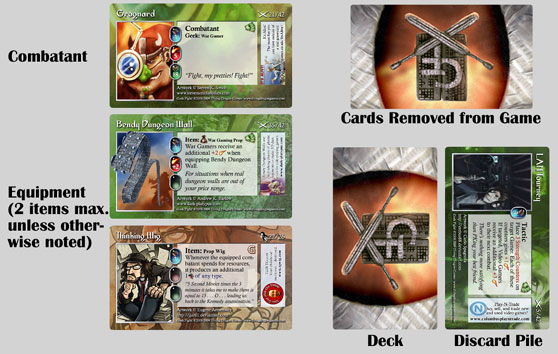
Each player has one Combatant in play at a time, under whom are up to two pieces of Equipment, which are card types we call Items. Effect-based cards called Tactics and Skills may also be used to influence the game; those have one-time effects and are played straight into the Discard Pile. Pretty basic, right? Now, let's take a closer look at those cards. . . .
Types of Cards
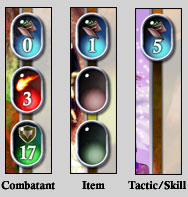
Combatants
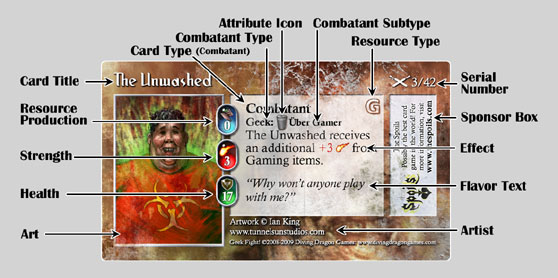
This card type has numbers in each of the three jewels, which represent, from top to bottom:
 Resource Production
Resource Production
 Strength
Strength
 Health
Health
The Combatant is the card around which Geek Fight revolves. Combatants are played for free but can only be deployed during the Enter the Arena Phase. Combatants also generate resources (Tokens, Cash, etc.) that can be spent on Items, Tactics, and Skills. (See Combat to learn how to spill the blood of your enemies.) Over the course of the game, damage may be dealt to the Combatant through various means. Damage is cumulative. When a Combatant accumulates an amount of damage greater than or equal to its health plus any modifiers, it is defeated, at which point it is discarded from play.
Each Combatant has a Type and Subtype (see diagram above), which allows him or her to use certain Tactics, Skills, and Items with extra effects, such as added attack power. Certain Combatants and other cards have special personality traits in addition to Type and Subtype, which are indicated by an Attribute Icon before their Subtype (see Attributes).
Tactics
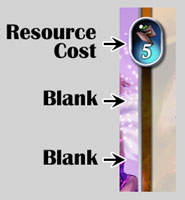 This card type has a number in the blue resource jewel, which represents the cost to play the card, but it has no numbers in the strength (red) or health (green) jewels. Tactics can only be used by the player whose turn it is (hereafter referred to as the active player) when the LIFO (Last In, First Out) Queue is empty. Tactics are generally used to support or hinder Combatants. When you play a Tactic, its Effect occurs once during the turn in which it is played; place the Tactic directly into your discard pile.
This card type has a number in the blue resource jewel, which represents the cost to play the card, but it has no numbers in the strength (red) or health (green) jewels. Tactics can only be used by the player whose turn it is (hereafter referred to as the active player) when the LIFO (Last In, First Out) Queue is empty. Tactics are generally used to support or hinder Combatants. When you play a Tactic, its Effect occurs once during the turn in which it is played; place the Tactic directly into your discard pile.
Skills
Like Tactics, Skills have a number in the resource jewel. Skills are the fastest acting cards in the game, entering the Queue with the same priority as Activated and Triggered Abilities (see Abilities). Skills can be used at any time, even during another player's turn, as long as you have Control (see LIFO Queue). Skills may directly affect the arena but may also target other things, including Combatants, Items, Tactics, and even other Skills! Since Skills may target one another, it's important to note that they resolve in the order of last in, first out. The most recently played Skill happens first (see LIFO Queue). When you use a Skill, place it your discard pile.
Items
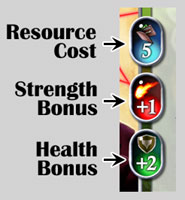 Items have a number in the blue resource jewel, which represents the cost to play the card. Items may also have numbers in the strength and health jewels but with a plus (+) or minus (-) symbol in front of the number. Items can only be played by the active player when the LIFO Queue is empty. Items remain in play and are immediately equipped by the targeted Combatant. If a Combatant leaves play, all Items that were equipped to it remain in play and are automatically equipped to the next Combatant its controller deploys. Unless otherwise stated, a Combatant can only equip two Items at once. If there are more Items in play than a Combatant can equip, their controller chooses which Items he/she will keep in play; the others are automatically bartered (see Spending and Bartering).
Items have a number in the blue resource jewel, which represents the cost to play the card. Items may also have numbers in the strength and health jewels but with a plus (+) or minus (-) symbol in front of the number. Items can only be played by the active player when the LIFO Queue is empty. Items remain in play and are immediately equipped by the targeted Combatant. If a Combatant leaves play, all Items that were equipped to it remain in play and are automatically equipped to the next Combatant its controller deploys. Unless otherwise stated, a Combatant can only equip two Items at once. If there are more Items in play than a Combatant can equip, their controller chooses which Items he/she will keep in play; the others are automatically bartered (see Spending and Bartering).
Items: Weapons and Armor
A weapon is an Item that gives a strength bonus, while armor gives a health bonus. Items that give bonuses to both stats are considered weapons AND armor. Strength and health bonuses are added to the respective strength and health values of the Combatant equipping the Item.
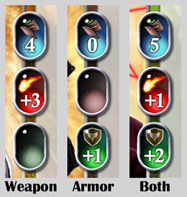
Card Attributes
Some cards have symbols indicating additional properties beyond Type or Subtype. These are Attributes. Below is a list of possible Attributes:
 |
Smelly |
 |
Fan |
 |
Angry |
 |
Cute |
 |
Tank |
 |
Swag (Items only) |
 |
Artistic |
 |
Musical |
 |
Literary |
 |
Cinematic |
 |
Caffeinated |
 |
Blazing |
Combatants with these Attributes may gain special abilities from certain Tactics, Skills, or Items that average Combatants do not. For example, Smelly Combatants don't have to spend to play Vicious B.O.
LIFO (Last In, First Out) Queue
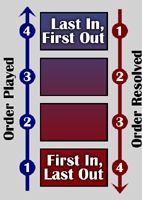 The LIFO Queue is our way of determining the order in which Effects and Abilities resolve. The term LIFO (Last In, First Out) comes from a common method of data processing in computer programming, where the most recent command (Last In) is the first to be processed (First Out). When a new Effect or Ability is played, it is added to the top of the LIFO Queue, which resolves from the top to bottom (see diagram to the right).
The LIFO Queue is our way of determining the order in which Effects and Abilities resolve. The term LIFO (Last In, First Out) comes from a common method of data processing in computer programming, where the most recent command (Last In) is the first to be processed (First Out). When a new Effect or Ability is played, it is added to the top of the LIFO Queue, which resolves from the top to bottom (see diagram to the right).
In order to add an Effect or Ability to the LIFO Queue, a player must have Control of the Queue. When the active player does something, the action is placed in the LIFO Queue, and Control immediately passes to the player to the left. Once the Queue resolves, the active player regains Control. Only the active player can play Items and Tactics or attack during the Action Phase, and only when the LIFO Queue is empty. Whenever a player has Control of the LIFO Queue, they may add an Effect or Ability to the Queue or pass Control to the player on their left. When each player passes without adding anything to the Queue, the Effects and Abilities already in the Queue resolve from top to bottom (Last In, First Out).
Example: Player 1 uses Guitar Guy to attack Player 3's Chester A. Bum. The LIFO Queue is activated, and Player 2 gets a chance to respond, but he decides to pass Control to Player 3. Player 3 uses Jump Cut to prevent the combat damage from Player 1's attack. Player 1 has no card in hand that can cancel Jump Cut, so the Queue resolves, and the attack has no effect. Then the Queue empties, and Player 1 regains Control.
Spending for resources, Abilities that only produce resources, and bartering can be done at any time by any player. These actions are not added to the LIFO Queue and resolve immediately. Resources created by these actions can be used to add other elements, like Skills, to the Queue. Skills can be used any time a player has Control. Some Abilities, such as Activated Abilities, can, like Skills, be played at any time and also go into the Queue.
Resources
Spending for Resources
A Combatant may spend once per round, not once per turn, in order to use one of its Spend Abilities or to produce the resources required to play Items, Tactics, or Skills. A Combatant may spend to use Spend Abilities any time its owner has Control of the LIFO Queue. This adds the Combatant's Ability to the Queue and passes Control to the next player. Spending to produce resources does not get added to the Queue and may be done anytime. These resources may be used to play other cards. A Combatant produces resources of the type indicated by the icon in the upper right corner of the Combatant's text box:
 |
Tokens |
 |
Tickets |
 |
Cash |
 |
Bandwidth |
 |
Generic |
 |

|
If a Combatant has more than one Resource Type, it produces any combination of the associated resources that its controller chooses, even only one type if desired. Items, Tactics, and Skills of the Generic type can be paid for with any resource. Spending does not prevent a Combatant from attacking or taking damage.
Bartering for Resources
Bartering is the act of forfeiting and discarding an Item from play in exchange for an amount of resources equal to 1/2 of its resource cost rounded up. The resources produced by bartering share the same type as the Item that was bartered to produce them. For example, a Thinking Wig with a cost of 3 Generic can be bartered for 2 Generic (half of 3 rounded up). If an Item has more than one Resource Type, bartering may produce any combination of the resources associated with the card. A player may barter an Item at any time, except when the Item is targeted by an Ability or Effect (i.e.,Steal Abilities, Tactics, Skills).
Using Resources
Items, Effects, and some Abilities require resources. Once resources are produced, the player that controls them may pay for Items, Tactics, Skills, or Abilities as long as it is their turn, or if they are in control of the Queue (although some actions, like Tactics, can be played only while you are the active player). The player may purchase Items/Tactics/Skills or use Abilities as long as one of the resource units produced by his or her Combatant is of the required type. In other words, an Item with a cost of 5 and a "Cash" Resource Type can be purchased using 1 Cash, as long as the player comes up with the remaining 4 resources in any type.
If a non-Combatant card, such as Jump Cut, has more than one Resource Type, then at least one resource from either type is needed to play it, not both. The rest of the resources used to play the card can be of any type.
When you generate resources, extra resources are set aside for later use but are removed from the game at the end of the round. Resources do not carry over to your next turn!
Effects
An Effect is any text on a Tactic or Skill that influences the game. Basically, if a card mentions an Effect, it's talking about a Tactic or Skill. If the target of an Effect is removed from play before the Queue resolves, the Effect is ignored. That's easy enough to remember, right? . . . Right?
Abilities
An Ability is any statement in the text area of a card in play that influences the game. It may happen only once or last as long as the card is in play. Unlike Effects, if the target of an Ability is removed from play before the Queue resolves, a new target must be chosen. The types of Abilities include:
Activated Abilities
Activated Abilities occur when a player chooses to activate them. Examples include: Spend Abilites, Sniping, Forfeit Abilities, and Abilities for which a player pays a cost to activate. Spending for resources does not count as an Ability. The subtypes of Activated Abilities are as follows:
Forfeit Abilities
Some cards have Activated Abilities that require you to forfeit either the card with the Ability or forfeit another card or cards. To forfeit a card, you must discard it from play. Forfeiting can be done at any time. You may only forfeit a card if it or another card forces or allows you to. If a card requires you to make a Forfeit in order to play it, then the Forfeit takes place before the card's deployment goes on the Queue. Forfeiting Items does not count as breaking them, and forfeiting Combatants does not count as defeating them.
Sometimes, a Tactic or Skill may come with an Ability attached to it that activates under a particular condition. For example, a Tactic would be an Effect under normal circumstances, but a Forfeit performed in order to activate an Effect of the Tactic is considered a Forfeit Ability.
Spend Abilities
Spend Abilities require the Combatant performing them to "spend" before they happen. Sometimes, Spend Abilities will require that a specific amount of resources be used to activate the Ability. Cards that simply say, "Combatant may spend to ____" are presumed to require the Combatant to spend all of its resources at once, meaning he or she cannot activate the Spend Ability after using even one resource for another purpose. Unless otherwise stated on the card, Spend Abilities occur with the same speed as Skills.
Sniping
 Some Combatants or Items have a Snipe Value (SV) in the bottom right corner of their text boxes. If a Combatant you control has an SV or is equipping an Item with an SV, you may snipe. When a Combatant snipes, it deals direct damage to another target Combatant equal to either its own SV or the SV of one Item it equips. Basically, even if your Combatant is equipping two Items that both have SVs, you can only snipe with one Item at a time; the values don't add up. A Combatant cannot snipe if it has already sniped or attacked during the round.
Some Combatants or Items have a Snipe Value (SV) in the bottom right corner of their text boxes. If a Combatant you control has an SV or is equipping an Item with an SV, you may snipe. When a Combatant snipes, it deals direct damage to another target Combatant equal to either its own SV or the SV of one Item it equips. Basically, even if your Combatant is equipping two Items that both have SVs, you can only snipe with one Item at a time; the values don't add up. A Combatant cannot snipe if it has already sniped or attacked during the round.
Triggered Abilities
Triggered Abilities happen when a condition is met, and only once per condition. Example: When Super Mecha Death Christ is deployed, his controller must discard a card at random as the result of a one-time condition.
Conditional Abilities
Conditional Abilities happen once a condition is met and then remain active as long as the condition remains. The most common examples of this are weapons that gives an additional +2 strength when equipped to Combatants with certain Types/Subtypes.
Static Abilities
Static Abilities are active from the moment a card enters play until the card leaves play. For example, the Price Gouger has a Static Ability that makes Items played by opponents cost one extra resource for as long as he stays in play.
Phases of Play
Beginning the Game
Before the game begins, each player selects three Combatants from their deck and places them to the side. After this step, each player shuffles his or her deck and draws four more cards. When each player has seven cards in hand, he or she decides which Combatant to deploy facedown. Once the Combatants are chosen, all players reveal them simultaneously.
When everyone has revealed their Combatants, players may determine who goes first through whatever method they agree upon. The first person to go may choose either to attack or spend on their first turn (see Combat and Spending), but they cannot do both until their next turn. The second player to go has no restrictions and may attack or spend at will.
To avoid complications, V.I.P Combatants cannot be deployed at the beginning of the game. (See Phase 2 - Enter the Arena.)
Each turn progresses through four phases:
Phase 1: Draw
Phase 2: Enter the Arena
Phase 3: Action
Phase 4: End of Turn
Phase 1 - Drawing Cards
At the beginning of each player's turn, if he or she has less than 7 cards in hand, they may draw a card from the top of their deck. If they have 7 or more cards in hand at the start of their turn, they may choose not to draw, or they may draw one card and place any card in their hand facedown on the bottom of their deck. (No need to discard! That would just be mean.)
Phase 2 - Enter the Arena
During this phase, each player must deploy a Combatant from their hand unless they already have one in play. A player can only have one Combatant in play at a time. If a player has no Combatants in play and cannot deploy another, they lose the game. The game ends when only one player remains. No cards can be played and no Abilities can be used during this phase. NOTE: If a Combatant's subtype is "V.I.P. ____," he or she is a Very Important Person and a unique character. There cannot be two V.I.P. cards with the same name in the arena at any time. For example, if you've deployed a Combatant called Chester A. Bum, no one else can control a Chester A. Bum until yours leaves the arena. If another copy is deployed by any player, even if that player does not control the V.I.P., the new one is automatically defeated.
Phase 3 - Action
After the Enter the Arena Phase ends, the Action Phase begins. During the Action Phase, the active player may attack or play Items, Tactics, and Skills. To play these cards, a Combatant must "spend" his or her resources. (See Spending.) A player may attack at any time during the Action Phase, which leads us to . . .
Combat
Unless otherwise stated, Combatants can only attack during their controller's Action Phases when there are no actions in the LIFO Queue. When a Combatant attacks, it selects a Combatant controlled by another player. This action initiates the LIFO Queue and passes Control of the Queue to the player on the left and so on until all players pass Control. When the LIFO Queue resolves, the attacking Combatant deals an amount of damage to the defending Combatant equal to its strength value. If either Combatant is removed from play during the course of resolving the LIFO Queue, the attack has no effect and is ignored; but if the defending Combatant is removed from play before combat resolves, the attacking Combatant cannot select a new target to attack.
Phase 4: End of Turn
The End of Turn Phase automatically initiates the LIFO Queue, allowing each player the chance to play an Effect or Ability. However, when the active player moves into their End of Turn Phase, Control of the Queue automatically passes to the player to the left, who may then add an Effect or Ability to the Queue or pass Control. Once everyone has passed Control without adding anything to the Queue, any outstanding Effects or Abilities will resolve normally. After the Queue empties, Control returns to the player to the left of the active player, who again has the option to either add to the Queue or pass Control. If all players pass Control without taking action for a full cycle, the turn ends. (In layman's terms, everyone has a chance to do something before the end of any player's turn, and the turn does not end until everyone passes.)
Counters
Resource and Tax Counters
 Certain Effects or Abilities may require the player to place Resource or Tax Counters on a Combatant or Item. Resource Counters placed on Combatants (or Items they equip) make those Combatants generate a bonus +1 resource per turn.
Certain Effects or Abilities may require the player to place Resource or Tax Counters on a Combatant or Item. Resource Counters placed on Combatants (or Items they equip) make those Combatants generate a bonus +1 resource per turn.
If a Tax Counter is placed on a Combatant or an equipped Item, it reduces the Combatant's resource generation by -1.
Strength and Frailty Counters
 Strength and Frailty Counters work in pretty much the same way as Resource and Tax Counters, except these affect the red strength jewel. If a Strength Counter is placed on a Combatant, it gives the Combatant a bonus of +1 strength. If a Strength Counter is placed on an Item, it increases the strength bonus the Item gives by +1.
Strength and Frailty Counters work in pretty much the same way as Resource and Tax Counters, except these affect the red strength jewel. If a Strength Counter is placed on a Combatant, it gives the Combatant a bonus of +1 strength. If a Strength Counter is placed on an Item, it increases the strength bonus the Item gives by +1.
If a Frailty Counter is placed on a Combatant, it reduces the Combatant's strength by -1. Each Frailty Counter placed on an Item reduces the Item's strength bonus by -1.
Health and Sickness Counters
 Health and Sickness Counters affect the green health jewel. Health Counters placed on Combatants (or Items they equip) give those Combatants +1 health. Sickness Counters give -1 health. Negative health modifiers are not damage; they are reductions in a Combatant's maximum health value that remain in place as long as the Sickness Counter is present.
Health and Sickness Counters affect the green health jewel. Health Counters placed on Combatants (or Items they equip) give those Combatants +1 health. Sickness Counters give -1 health. Negative health modifiers are not damage; they are reductions in a Combatant's maximum health value that remain in place as long as the Sickness Counter is present.
Negative Modifiers
Though certain values, such as resource production and strength, can be reduced, they cannot by any means be reduced below 0. Anything that reduces a value is called a negative modifier. For example, if a Combatant with 3 strength receives 4 Frailty Counters, he or she would have 0 strength, not -1 strength.
However, the excess negative modifiers are still taken into account when other bonuses are applied to the values that were reduced. If the Combatant from our first example equips an Item that gives +2 strength, he or she only receives +1 strength when the fourth Frailty Counter is factored in. The same can be said for Items. The difference between negative modifiers on Items and on Combatants is that when a Combatant has a negative modifier applied to its strength or health, the modifiers that would drop the value below 0 are taken into account when new bonuses are applied. But if there are excess negative strength or health modifiers on an Item, they do not affect the Combatant or other Items equipped by the Combatant; the Item bonus simply drops to 0. However, if the Item in question receives a positive modifier, the excess negative modifiers are taken into account just like with the Combatant.
Distraction Counters
As long as a Distraction Counter is on a Combatant, he or she cannot attack. At the end of the Combatant's controller's turn, one Distraction Counter is removed. Thus, if two Distraction Counters are placed on a Combatant during its controller's turn, one of them will be removed immediately at the end of the turn. Once all Distraction Counters are gone, the Combatant may attack again.
Card-Specific Counters and Tokens
Certain Abilities and Effects create counters or tokens other than the ones described here. In those cases, the effects of the counters will be explained on the card that creates them.
Winning and Losing
Playing for Combatants
A player loses after their last available Combatant is defeated and they can no longer replace it. This may occur even if Combatants remain in the deck but are not in the player's hand. When a player's last Combatant is defeated, the player remains in the game until the beginning of their next turn, at which point they may draw a card. If the player cannot play a Combatant after their Draw Phase, he or she loses the game.
Playing for Cred
Cred stands for "Credibility" and is kind of like your geek reputation. Once your Cred gets high enough, not even a fool will pick a fight with you! Whenever a player defeats a Combatant they do not control using damage, that player gains 2 Cred. If a Combatant is defeated as the result of an Effect or Ability that does not deal damage, no one gains Cred. When a player reaches an agreed upon amount of Cred (generally 10), that player wins the game. When playing for Cred, a player will still lose the game if they cannot deploy a Combatant.
Remember: If the card's text contradicts any of these rules, heed the card!

